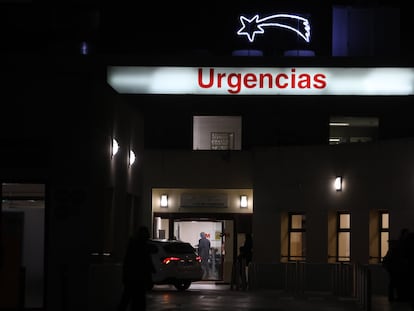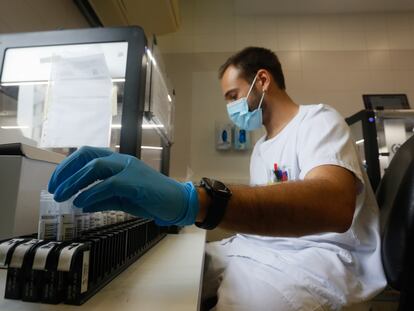How to reduce the risk of coronavirus contagion over Christmas
Office dinners, meals out with friends and family, car rides and end-of-year celebrations are the perfect breeding ground for the virus, but preventive measures can lower the likelihood of infection
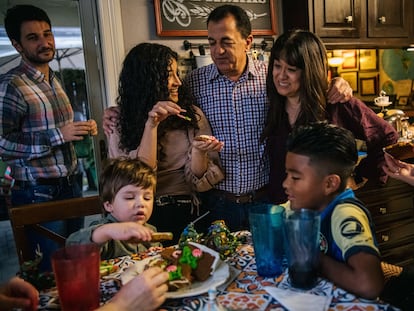
Celebrating the Christmas festive season without taking precautions to prevent the spread of the coronavirus is a high-risk situation. Indoor dining, whether with workmates, friends or family, makes the Christmas and New Year’s Eve celebrations a perfect breeding ground for the virus. Vaccination has proven effective in preventing the development of severe cases of Covid-19, but transmission still depends on the awareness and application of health protection measures.
Now the TEP130-ArqWellness research team at Seville University has developed a calculator called Covid Risk airborne. This tool, which is available for free on the internet, estimates the risk of transmission via aerosols, both in medium and long-distance proximity, according to the Wells-Riley model for the spread of airborne diseases, which has been adapted to SARS-CoV-2 by Professor José Luis Jiménez from Boulder University, Colorado, in the United States.
Miguel Ángel Campano, from the TE-130 group of Architecture, Heritage and Sustainability behind the team, explains: “It allows us to see what is happening in any given venue in a very accurate way, and is designed for the owners or managers of premises, as well as anyone wanting to assess and anticipate the risks at a forthcoming event.”
The risk of coronavirus contagion may exist, but there are multiple measures that can be combined to minimize it; namely: ventilation, air filters, properly fitted masks, social distancing and reducing the duration of an event. The Covid Risk airborne calculator incorporates all these measures into its analysis.
The following is an examination of high-, medium- and low-risk scenarios in four common types of Christmas gatherings, based on 206 hypotheses detailed for the preparation of this report. In each scenario, the risk level is estimated on the basis that 78% of the attendees are fully vaccinated (the current rate in Spain), the delta variant is the dominant coronavirus strain and just one person is carrying the virus.
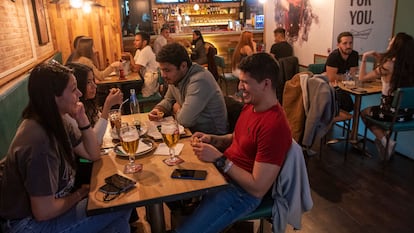
Lunch with co-workers and friends
High risk. A total of 25 colleagues and friends, 78% of whom are vaccinated, gather without masks in a room measuring 63 square meters and three meters in height. They talk loudly and move little, standing or sitting for three hours. There is no dancing or singing. As the windows are closed, the concentration of carbon dioxide (CO₂) rises during the event to an average of 2,813 parts per million – the recommended air quality index (AQI) during the pandemic is below 700. This indicator makes it indirectly possible to assess the level and quality of air previously breathed. In the event of one positive Covid case in a roomful of unvaccinated diners, 27% would run the risk of becoming infected by medium and long-distance aerosol transmission, given that air filters are not common. But, with 79% of the attendees vaccinated, the number of possible cases falls to an average of 3.01. By simply opening windows for air renewal, it would also be possible to halve the risk and number of possible contagions.
Medium risk. In the same premises, with the same mask-free diners mixing under the same conditions, cross-ventilation measures could improve air quality, achieving a concentration of CO₂ of 550 parts per million, which is the limit recommended by the analysis group Aireamos for spaces without masks, such as hotels and early childhood centers. This measure would reduce the percentage of people vulnerable to infection to 3.4%, thereby lowering the number of possible cases to 0.37.
Low risk. At some company or group events, there may be an acceptable level of risk, but it is still important for both the venue and those present to take precautions. In this scenario, we have the same conditions and the same number of diners, but this time they are wearing FFP2 masks correctly during 75% of the three hours and have all been vaccinated. The venue complies with the Regulation of Thermal Installations in Buildings (RITE) in terms of ventilation and has the filtering systems required for this type of installation (IDA 3). In this scenario, only 0.30% of the diners would be statistically susceptible to infection.
Based on this example, Campano explains that the hospitality industry should not be blamed in general for being a source of coronavirus transmission. He argues that establishments that comply with ventilation regulations and have adapted to the conditions imposed by the pandemic should be recognized, as the risk in these premises can be quite small.

Family gathering
High risk. A total of 14 people gather for four hours in a room measuring 22 square meters and 2.7 meters in height. The windows closed and there is no HEPA air filter – a type of air purifier that has a high-efficiency particle arresting (HEPA) filter capable of retaining the bioaerosols that are suspended in the air, but also of allowing gases to pass through. Prices for these filters start from €80 ($91).
The people gathered are sitting and the conversation is loud. None of them wear masks and 78% are vaccinated, given that there are children (Covid-19 vaccines have yet to be rolled out for the under-12s in Spain) and people who have chosen not to get immunized. During that time, the average CO₂ concentration is 5,647 parts per million compared to the recommended 550. If none of those present were vaccinated, 77% would be susceptible to infection, but due to the effectiveness of the vaccines, in this scenario, the number of possible cases would fall to an average of 4.55. If the windows were left ajar at the same celebration, the potential for infection would drop to 1.77 cases.
Medium risk. During a dinner within the same scenario, a continuous, measured and evenly distributed cross ventilation (CCDM) is used to reduce and maintain the average CO₂ concentration to 550 parts per million and a HEPA air purifier is used to remove the possible viral load from the air. The percentage of potential infections drops drastically to 7% and the number of potential cases is only 0.41 thanks to the protection from the Covid-19 vaccines.
Low risk. None of the 38 scenarios analyzed falls into this category, although if all diners were vaccinated, and cross-ventilation and air purifiers were used, the number of possible cases would be reduced to 0.24. The use of masks when not eating would also reduce the risk considerably. An alternative, if available, is to try to find a larger space to help dilute the viral load in the air. Another strategy would be to limit the number of diners.
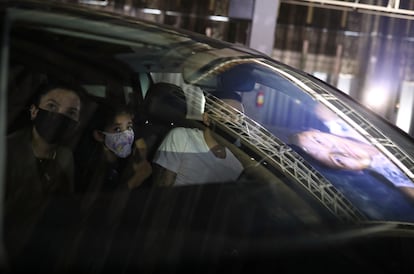
Car
High risk. The Christmas dinner or lunch is over, but the party continues. Diners get into cars to continue the celebration at another venue. One of the vehicles is a conventional family model with an interior of about five cubic meters. Of the five occupants, one is not vaccinated and none of them is wearing a mask. During the 45-minute drive, they talk animatedly. The windows are closed and there’s no ventilation either through open windows or from the car’s ventilation system. In this scenario, one or two of the occupants could be infected.
Medium risk. Only one measure can make the vehicle safer and reduce the possible number of cases to 0.15: rolling down all the windows by five to 10 centimeters.
Low risk. The car, which is inherently high risk, can be almost innocuous if FFP2 masks are worn during the entire journey, all occupants are vaccinated and the vehicle’s ventilation system is turned on or windows are half opened. By applying some of these preventive measures, the risk of medium-distance transmission is practically zero. Although the possible transmission by aerosols in close proximity has not been assessed in the study, the combination of these measures may be the optimal course of action.
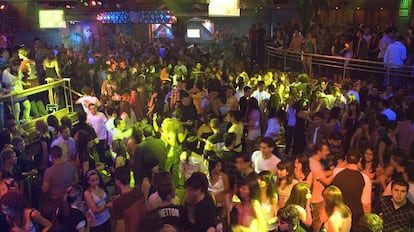
Party venue
High risk. As in all previous cases, this scenario corresponds to a real party venue. The site is 430 square meters and 3.2 meters in height, with closed windows and no air filters. Inside, there are 300 people (78% vaccinated) without masks. The celebration lasts for five hours, with dancing and loud conversations and some singing. In the event that one of the party-goers is infected and none of them is vaccinated, there is a statistical average probability of 133 occupants being susceptible to infection. Taking into account the efficacy of vaccines against infection, the probability of cases in this scenario is 77.19.
Medium risk. To bring down the risk in this venue, it would be necessary to incorporate an IDA 3 filter (the kind required for these types of premises) and RITE ventilation, which is standard for public spaces. “These are not as widespread as they should be,” says Campano. Their use would reduce the average concentration of CO₂ to 868 parts per million. In addition, those present would have to wear properly fitted FFP2 masks at least 75% of the time. Only then would the average number of cases drop to 0.52.
Low risk. As in the case of family dinners, none of the scenarios analyzed had the conditions to be considered low risk. The best scenario, with 0.4% of people susceptible to infection, would be in a venue that complies with ventilation regulations, where masks are used for more than four hours and all 300 people vaccinated.
The analysis of the 206 scenarios with the Covid Risk airborne calculator was carried out by the Architecture, Heritage and Sustainability group from Seville University, which includes Miguel Ángel Campano, Samuel Domínguez-Amarillo, Ignacio Acosta, Jessica Fernández-Agüera, Pedro Bustamante and Juan José Sendra, with the participation and collaboration of José Luis Jiménez, from Boulder University in Colorado, Juan Diego Velarde (web developer) and the Aireamos and VentilANDo platforms. As possible short-distance transmission – the inhalation of aerosols close by – has not been factored in with this calculation model, the researchers recommend maintaining social distance while keeping in mind that masks and ventilation are also effective at limiting transmission.
“The most important thing to know, besides whether an event carries an acceptable risk, is how to lower it,” explains Campano. “This calculator provides the guidelines to do so by improving air quality, either with ventilation, air filters or masks. The importance of vaccination can also be determined.”
Antigen testing is also useful for those attending Christmas parties or dinners, as it could prevent asymptomatic people from spreading the virus, says Campano. “It provides an extra layer of security,” he explains. “But there are other measures, such as regulated ventilation using CO₂ meters – which also avoid over-ventilating and save energy, something which is pertinent at this time [given the soaring energy costs]. It is a case of bearing in mind that there are solutions and Christmas does not have to involve punishments for the population.” According to Campano, with these tools, restrictions will not need to be placed on either families or the hospitality industry.
Tu suscripción se está usando en otro dispositivo
¿Quieres añadir otro usuario a tu suscripción?
Si continúas leyendo en este dispositivo, no se podrá leer en el otro.
FlechaTu suscripción se está usando en otro dispositivo y solo puedes acceder a EL PAÍS desde un dispositivo a la vez.
Si quieres compartir tu cuenta, cambia tu suscripción a la modalidad Premium, así podrás añadir otro usuario. Cada uno accederá con su propia cuenta de email, lo que os permitirá personalizar vuestra experiencia en EL PAÍS.
¿Tienes una suscripción de empresa? Accede aquí para contratar más cuentas.
En el caso de no saber quién está usando tu cuenta, te recomendamos cambiar tu contraseña aquí.
Si decides continuar compartiendo tu cuenta, este mensaje se mostrará en tu dispositivo y en el de la otra persona que está usando tu cuenta de forma indefinida, afectando a tu experiencia de lectura. Puedes consultar aquí los términos y condiciones de la suscripción digital.
More information
Archived In
Últimas noticias
Most viewed
- Reinhard Genzel, Nobel laureate in physics: ‘One-minute videos will never give you the truth’
- Oona Chaplin: ‘I told James Cameron that I was living in a treehouse and starting a permaculture project with a friend’
- Pablo Escobar’s hippos: A serious environmental problem, 40 years on
- Why we lost the habit of sleeping in two segments and how that changed our sense of time
- Chevy Chase, the beloved comedian who was a monster off camera: ‘Not everyone hated him, just the people who’ve worked with him’

